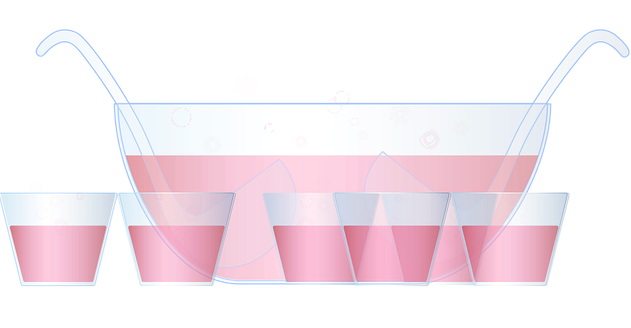

Su is going to make punch for her friends. She wants to mix \(3\) L of orange juice, \(1\) L of pop, \(\frac{1}{2}\) L of grape juice, and \(300\) mL of cranberry juice in a punch bowl.
To avoid spilling, Su plans to use a punch bowl with a capacity of at least \(200\) mL more than the liquid it holds. What is the smallest capacity that her punch bowl should have?
Su has cups that can each hold \(300\) mL of punch. How many of these cups can she fill with the punch she makes?

The smallest capacity of the punch bowl is the sum of the volumes of each liquid, plus the \(200\) mL of extra space to avoid spilling.
One way to calculate this would be to convert all the volumes to millilitres.
\(3~\text{L} = 3000\) mL
\(1~\text{L} = 1000\) mL
\(\frac{1}{2}~\text{L} = 500\) mL
So the minimum capacity is \(3000 + 1000 + 500 + 300 + 200 = 5000\) mL.
Alternatively, we might notice that the sum of the volume of cranberry juice and the extra room for spillage is: \(300 + 200 = 500\) mL or \(\frac{1}{2}\) L.
So the minimum capacity is \(3 + 1 + \frac{1}{2} + \frac{1}{2} = 5\) L.
The volume of punch is \(3000 + 1000 + 500 + 300 = 4800\) mL.
We can use skip counting to figure out how many cups of punch Su can fill:
\(300\), \(600\), \(900\), \(1200\), \(1500\), \(1800\), \(2100\), \(2400\), \(2700\), \(3000\), \(3300\), \(3600\), \(3900\), \(4200\), \(4500\), \(4800\)
We can see from this that Su can fill \(16\) cups with punch.
Alternatively, we can calculate the number of cups of punch by dividing \(4800 \div 300 = 16\) cups.